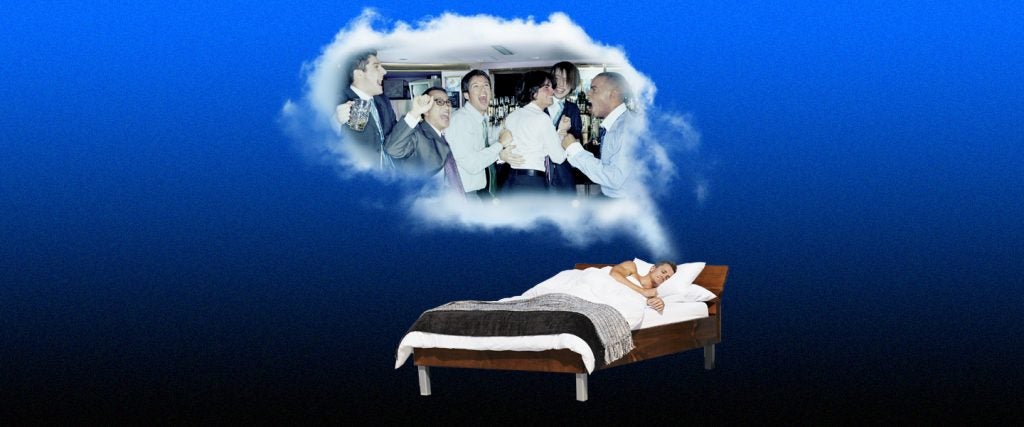After I had a few beers with a buddy recently, I brought up the topic of dreams. He told me he doesn’t always remember his, but when he does, he’s usually fighting zombies, training for war in a boot-camp scenario or jamming out on the guitar in front of an enthusiastic crowd. But all of these very different dreams shared one very distinct thing in common: There were no women in them. In fact, women were noticeably absent.
Statistically, my friend isn’t unique. Studies show that women’s dreams generally have an even number of men and women represented, but men’s dreams? Welcome to a dreamland sausage fest, because they typically feature twice as many dudes.
“Men tend to have more male than female characters in their dreams,” confirms dream researcher Kelly Bulkeley. As the director of the Sleep and Dream Database, a publicly available dataset featuring thousands of dreams, as well as the author of the book Big Dreams, Bulkeley has seen dream research evolve over the past few decades, but the gender gap between men and women’s dreams has been relatively consistent across age groups and cultures. Men’s dreams also tend to follow other gendered trends, like featuring more physical aggression, massive disasters and even insects.
Obviously, this isn’t true for all men, but the trends are consistent enough “that it raises the inevitable questions of nature versus nurture,” Bulkeley explains. For his part, Bulkeley believes it’s likely both: “Our dreams are inevitably shaped by the innate qualities of our bodies, minds and instinctual desires. Our dreams are also inevitably impacted by experiences with our families, friends and cultural communities.”
To understand how this turns men’s dreams into sausage fests, it’s important to consider why people dream in the first place. Freud suspected that our dreams served as windows into our unconscious desires, and yet, my friend definitely doesn’t want to secretly enlist in the army in his mid-30s (to fight zombies or otherwise). Other studies suggest that our dreams help us sort through and consolidate our memories. However, G. William Domhoff, a distinguished professor emeritus and research professor of psychology at the University of California, Santa Cruz, believes dreams really aren’t that meaningful.
“The best way to think about our capacity to dream is that it’s an accidental byproduct of our waking cognitive abilities,” Domhoff explained in a press release for his 2017 book, The Emergence of Dreaming: Mind-Wandering, Embodied Simulation and the Default Network. “Humans have invented uses for dreams in religious and healing rituals, which speaks to how central they are to human experience. But in an evolutionary sense, they don’t serve a purpose.”
By looking at men’s dreams as a chaotic distillation of their conscious lives and biological impulses, it starts to make sense as to why they feature a disproportionate amount of men, Bulkeley explains. Although there’s more casual crossover between men and women in the workplace and friendships now, a lot of men still go through most of their lives rarely interacting with women outside of their families and romantic relationships. By contrast, women are more often socialized to be nurturing, accommodating and relational, and tend to have a more even representation of genders in their interactions.
The tendency toward nightmares about violent, world-ending calamities may also influence this dream gender gap, because a lot of guys aren’t going to picture women in those scenarios. As for where such dreams originate from, it’s easy to assume violent movies, TV and video games could play a role, but Bulkeley wonders “what’s the chicken and what’s the egg” — e.g., as a kid who grew up before the video-game era, Bulkeley still recalls having plenty of violent nightmares.
“That’s fairly common among both males and females — from an evolutionary perspective, such nightmares can actually be helpful in priming humans for possible threats and dangers in the waking world,” he explains. Entertainment merely caters to these impulses, which is why he’s found that video-game makers and VR researchers are particularly interested in his dream data. “The closer to ‘dream-like immersion’ they can get, the more successful their games.”
Sex dreams may be the one exception to this trend, which are common among men and women, but studies show that men have slightly more of them — about 21 percent of men’s dreams are about sex, compared to 16 percent of women’s.
It’s important to note that dream trends are taken from a very zoomed-out lens, Bulkeley says, and as dream databases like his own expand, researchers will have better opportunities to look at more nuanced differences in how people dream. For instance, when Bulkeley entered data from his own 1,000 dreams tracked between 2019 and 2021, they featured 51 percent women to 41 percent men. “So there’s a lot of individual variation here, too,” he says.
In other words, the sausage party of your dreams might be nearing its last call.

